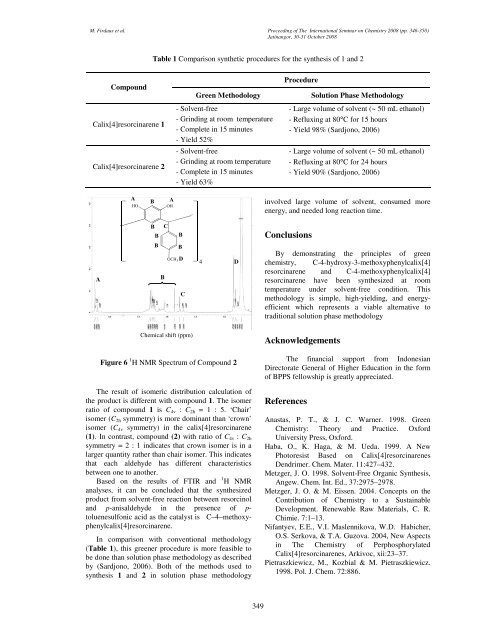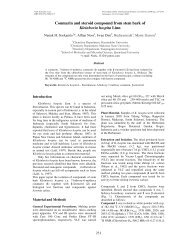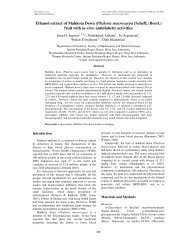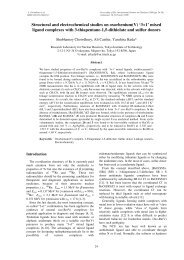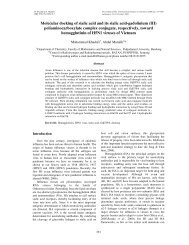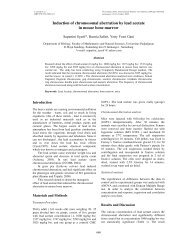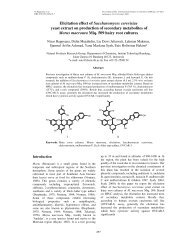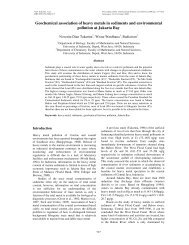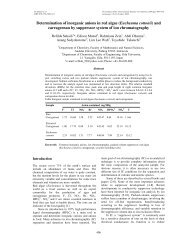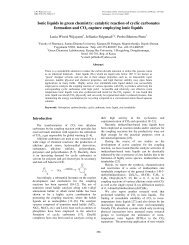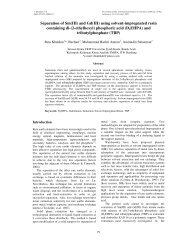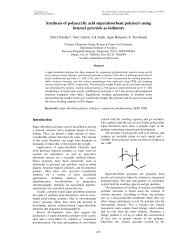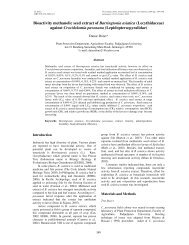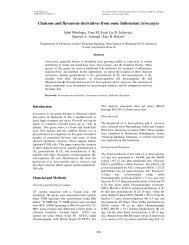Green Synthesis of C-4-Hydroxy-3-methoxyphenylcalix[4 ...
Green Synthesis of C-4-Hydroxy-3-methoxyphenylcalix[4 ...
Green Synthesis of C-4-Hydroxy-3-methoxyphenylcalix[4 ...
- No tags were found...
Create successful ePaper yourself
Turn your PDF publications into a flip-book with our unique Google optimized e-Paper software.
M. Firdaus et al. Proceeding <strong>of</strong> The International Seminar on Chemistry 2008 (pp. 346-350)Jatinangor, 30-31 October 2008Table 1 Comparison synthetic procedures for the synthesis <strong>of</strong> 1 and 2CompoundCalix[4]resorcinarene 1Calix[4]resorcinarene 2<strong>Green</strong> Methodology- Solvent-free- Grinding at room temperature- Complete in 15 minutes- Yield 52%- Solvent-free- Grinding at room temperature- Complete in 15 minutes- Yield 63%ProcedureSolution Phase Methodology- Large volume <strong>of</strong> solvent (~ 50 mL ethanol)- Refluxing at 80°C for 15 hours- Yield 98% (Sardjono, 2006)- Large volume <strong>of</strong> solvent (~ 50 mL ethanol)- Refluxing at 80°C for 24 hours- Yield 90% (Sardjono, 2006)AHOBAOH*involved large volume <strong>of</strong> solvent, consumed moreenergy, and needed long reaction time.A*B CB BB BOCH 3 DBC4DConclusionsBy demonstrating the principles <strong>of</strong> greenchemistry, C-4-hydroxy-3-<strong>methoxyphenylcalix</strong>[4]resorcinarene and C-4-<strong>methoxyphenylcalix</strong>[4]resorcinarene have been synthesized at roomtemperature under solvent-free condition. Thismethodology is simple, high-yielding, and energyefficientwhich represents a viable alternative totraditional solution phase methodologyChemical shift (ppm)AcknowledgementsFigure 6 1 H NMR Spectrum <strong>of</strong> Compound 2The result <strong>of</strong> isomeric distribution calculation <strong>of</strong>the product is different with compound 1. The isomerratio <strong>of</strong> compound 1 is C 4v : C 2h = 1 : 5. ‘Chair’isomer (C 2h symmetry) is more dominant than ‘crown’isomer (C 4v symmetry) in the calix[4]resorcinarene(1). In contrast, compound (2) with ratio <strong>of</strong> C 4v : C 2hsymmetry = 2 : 1 indicates that crown isomer is in alarger quantity rather than chair isomer. This indicatesthat each aldehyde has different characteristicsbetween one to another.Based on the results <strong>of</strong> FTIR and 1 H NMRanalyses, it can be concluded that the synthesizedproduct from solvent-free reaction between resorcinoland p-anisaldehyde in the presence <strong>of</strong> p-toluenesulfonic acid as the catalyst is C–4–<strong>methoxyphenylcalix</strong>[4]resorcinarene.In comparison with conventional methodology(Table 1), this greener procedure is more feasible tobe done than solution phase methodology as describedby (Sardjono, 2006). Both <strong>of</strong> the methods used tosynthesis 1 and 2 in solution phase methodologyThe financial support from IndonesianDirectorate General <strong>of</strong> Higher Education in the form<strong>of</strong> BPPS fellowship is greatly appreciated.ReferencesAnastas, P. T., & J. C. Warner. 1998. <strong>Green</strong>Chemistry: Theory and Practice. OxfordUniversity Press, Oxford.Haba, O., K. Haga, & M. Ueda. 1999. A NewPhotoresist Based on Calix[4]resorcinarenesDendrimer. Chem. Mater. 11:427–432.Metzger, J. O. 1998. Solvent-Free Organic <strong>Synthesis</strong>,Angew. Chem. Int. Ed., 37:2975–2978.Metzger, J. O. & M. Eissen. 2004. Concepts on theContribution <strong>of</strong> Chemistry to a SustainableDevelopment. Renewable Raw Materials, C. R.Chimie. 7:1–13.Nifantyev, E.E., V.I. Maslennikova, W.D. Habicher,O.S. Serkova, & T.A. Guzova. 2004, New Aspectsin The Chemistry <strong>of</strong> PerphosphorylatedCalix[4]resorcinarenes, Arkivoc, xii:23–37.Pietraszkiewicz, M., Kozbial & M. Pietraszkiewicz.1998. Pol. J. Chem. 72:886.349


